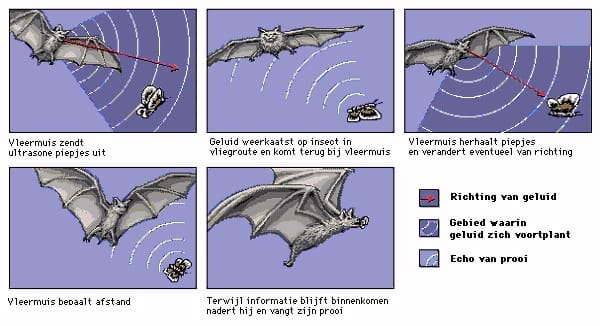Research has shown that the common pipistrelle, the common (brown) big-eared bat, and the Daubenton’s bat can be found within Tapijn. Bat expert Ger Beckers took us to Tapijn and opened up a new world for us with his ‘bat detector’, a device that transforms bat sounds so we can hear them. Ger explained that bats can use the structures created by the presence of humans (the flow of the Jeker, the city walls, the buildings) during their hunt for insects. They skim across the water, along walls, and between trees, using their calls to locate prey. We call this ‘echolocation’.
The sounds that we recorded with the bat detector that evening revealed that we heard the Daubenton’s bat, the common pipistrelle, and the serotine bat!
Characteristics:
Bats are active at dusk and at night. They are the only mammals that can really fly. Their wings are constructed in a special way. They have a flying membrane between the front legs and the torso, and between the hind legs and the tail. The front legs of the bat have drastically extended fingers.
Diet:
All bat species found in the Netherlands are insectivorous. In order to survive, a bat must eat a quarter to a third of its body weight in insects per night. For a bat, that means 300 mosquitoes, moths, and beetles per night.
Echolocation:
Bats are mainly active at night, but their eyes are not good enough to hunt small insects. Therefore, they can ‘see with their ears’. They do not use their eyes to observe their surroundings, but their ears. This so-called echolocation works as follows:
Bats make sounds that are higher than 20kHz (ultrasonic). The sound waves ‘bump’ into objects in their surroundings, which reflect the sound. With its well-developed ears, the bat can capture and position that reflected sound. A number of shrieks in a row ensure that the bat knows exactly where that delicious snack is located. Different species of bat use different frequencies for echolocation. That is how you can tell one from the other using a bat detector. In addition, bats can adjust the frequency to the conditions. For example, if it has just rained, drops cause sound to reflect differently and a bat adjusts the frequency of its call accordingly.
Habitat:
Bats do not live in one place all year round. They move depending on the circumstances. A distinction can be made between a number of ‘quarters’.
The distance between summer and winter quarters can sometimes be hundreds of kilometres.
– summer or nursery colony: females live here during the summer (usually in groups) to give birth and raise their young.
– summer or male quarters: males live in one place during the summer, sometimes alone, sometimes in groups. This is always in a different location than the females of the same species.
– temporary or couples quarters: both males and females also have quarters that they use only briefly. For example, when they move from the winter to the summer residence. After the summer, they move to special quarters where they stay for a short period of time.
– winter quarters: Bats hibernate in buildings, bunkers, ice cellars, quarries, and tree cavities.
